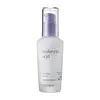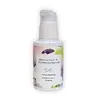What's inside
What's inside
 Key Ingredients
Key Ingredients

 Benefits
Benefits

 Concerns
Concerns

 Ingredients Side-by-side
Ingredients Side-by-side

Water
Skin ConditioningCyclomethicone
EmollientSodium Hyaluronate
HumectantIsohexadecane
EmollientButylene Glycol
HumectantGlycerin
HumectantMalpighia Emarginata Fruit Extract
Skin ConditioningPEG-11 Methyl Ether Dimethicone
EmulsifyingSodium Acrylate/Sodium Acryloyldimethyl Taurate Copolymer
Emulsion StabilisingPortulaca Oleracea Extract
Skin ConditioningVaccinium Angustifolium Fruit Extract
Skin ProtectingHydrogenated Polydecene
EmollientTriethanolamine
BufferingCaprylyl Glycol
EmollientPEG-40 Hydrogenated Castor Oil
EmulsifyingPPG-26-Buteth-26
Skin ConditioningAcrylates/C10-30 Alkyl Acrylate Crosspolymer
Emulsion StabilisingEthylhexylglycerin
Skin ConditioningParfum
MaskingCarbomer
Emulsion StabilisingLaureth-8
EmulsifyingDisodium EDTA
Hibiscus Sabdariffa Flower Extract
Skin ConditioningWater, Cyclomethicone, Sodium Hyaluronate, Isohexadecane, Butylene Glycol, Glycerin, Malpighia Emarginata Fruit Extract, PEG-11 Methyl Ether Dimethicone, Sodium Acrylate/Sodium Acryloyldimethyl Taurate Copolymer, Portulaca Oleracea Extract, Vaccinium Angustifolium Fruit Extract, Hydrogenated Polydecene, Triethanolamine, Caprylyl Glycol, PEG-40 Hydrogenated Castor Oil, PPG-26-Buteth-26, Acrylates/C10-30 Alkyl Acrylate Crosspolymer, Ethylhexylglycerin, Parfum, Carbomer, Laureth-8, Disodium EDTA, Hibiscus Sabdariffa Flower Extract
Water
Skin ConditioningButylene Glycol
HumectantGlycerin
Humectant1,2-Hexanediol
Skin ConditioningSodium Hyaluronate
HumectantPanthenol
Skin Conditioning3-O-Ethyl Ascorbic Acid
Skin ConditioningSodium PCA
HumectantPolysorbate 20
EmulsifyingGlycogen
HumectantAllantoin
Skin ConditioningEthylhexylglycerin
Skin ConditioningDisodium EDTA
Linoleic Acid
CleansingCentella Asiatica Extract
CleansingOleic Acid
EmollientPalmitic Acid
EmollientStearic Acid
CleansingLinolenic Acid
CleansingTocopherol
AntioxidantPEG-60 Hydrogenated Castor Oil
EmulsifyingParfum
MaskingCitronellol
PerfumingLimonene
PerfumingGeraniol
PerfumingLinalool
PerfumingButylphenyl Methylpropional
PerfumingWater, Butylene Glycol, Glycerin, 1,2-Hexanediol, Sodium Hyaluronate, Panthenol, 3-O-Ethyl Ascorbic Acid, Sodium PCA, Polysorbate 20, Glycogen, Allantoin, Ethylhexylglycerin, Disodium EDTA, Linoleic Acid, Centella Asiatica Extract, Oleic Acid, Palmitic Acid, Stearic Acid, Linolenic Acid, Tocopherol, PEG-60 Hydrogenated Castor Oil, Parfum, Citronellol, Limonene, Geraniol, Linalool, Butylphenyl Methylpropional
Ingredients Explained
These ingredients are found in both products.
Ingredients higher up in an ingredient list are typically present in a larger amount.
Butylene Glycol (or BG) is used within cosmetic products for a few different reasons:
Overall, Butylene Glycol is a safe and well-rounded ingredient that works well with other ingredients.
Though this ingredient works well with most skin types, some people with sensitive skin may experience a reaction such as allergic rashes, closed comedones, or itchiness.
Learn more about Butylene GlycolDisodium EDTA plays a role in making products more stable by aiding other preservatives.
It is a chelating agent, meaning it neutralizes metal ions that may be found in a product.
Disodium EDTA is a salt of edetic acid and is found to be safe in cosmetic ingredients.
Learn more about Disodium EDTAEthylhexylglycerin (we can't pronounce this either) is commonly used as a preservative and skin softener. It is derived from glyceryl.
You might see Ethylhexylglycerin often paired with other preservatives such as phenoxyethanol. Ethylhexylglycerin has been found to increase the effectiveness of these other preservatives.
Glycerin is already naturally found in your skin. It helps moisturize and protect your skin.
A study from 2016 found glycerin to be more effective as a humectant than AHAs and hyaluronic acid.
As a humectant, it helps the skin stay hydrated by pulling moisture to your skin. The low molecular weight of glycerin allows it to pull moisture into the deeper layers of your skin.
Hydrated skin improves your skin barrier; Your skin barrier helps protect against irritants and bacteria.
Glycerin has also been found to have antimicrobial and antiviral properties. Due to these properties, glycerin is often used in wound and burn treatments.
In cosmetics, glycerin is usually derived from plants such as soybean or palm. However, it can also be sourced from animals, such as tallow or animal fat.
This ingredient is organic, colorless, odorless, and non-toxic.
Glycerin is the name for this ingredient in American English. British English uses Glycerol/Glycerine.
Learn more about GlycerinParfum is a catch-all term for an ingredient or more that is used to give a scent to products.
Also called "fragrance", this ingredient can be a blend of hundreds of chemicals or plant oils. This means every product with "fragrance" or "parfum" in the ingredients list is a different mixture.
For instance, Habanolide is a proprietary trade name for a specific aroma chemical. When used as a fragrance ingredient in cosmetics, most aroma chemicals fall under the broad labeling category of “FRAGRANCE” or “PARFUM” according to EU and US regulations.
The term 'parfum' or 'fragrance' is not regulated in many countries. In many cases, it is up to the brand to define this term.
For instance, many brands choose to label themselves as "fragrance-free" because they are not using synthetic fragrances. However, their products may still contain ingredients such as essential oils that are considered a fragrance by INCI standards.
One example is Calendula flower extract. Calendula is an essential oil that still imparts a scent or 'fragrance'.
Depending on the blend, the ingredients in the mixture can cause allergies and sensitivities on the skin. Some ingredients that are known EU allergens include linalool and citronellol.
Parfum can also be used to mask or cover an unpleasant scent.
The bottom line is: not all fragrances/parfum/ingredients are created equally. If you are worried about fragrances, we recommend taking a closer look at an ingredient. And of course, we always recommend speaking with a professional.
Learn more about ParfumSodium Hyaluronate is hyaluronic acid's salt form. It is commonly derived from the sodium salt of hyaluronic acid.
Like hyaluronic acid, it is great at holding water and acts as a humectant. This makes it a great skin hydrating ingredient.
Sodium Hyaluronate is naturally occurring in our bodies and is mostly found in eye fluid and joints.
These are some other common types of Hyaluronic Acid:
Learn more about Sodium HyaluronateWater. It's the most common cosmetic ingredient of all. You'll usually see it at the top of ingredient lists, meaning that it makes up the largest part of the product.
So why is it so popular? Water most often acts as a solvent - this means that it helps dissolve other ingredients into the formulation.
You'll also recognize water as that liquid we all need to stay alive. If you see this, drink a glass of water. Stay hydrated!
Learn more about Water